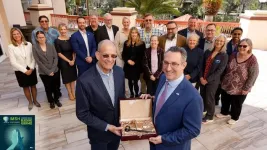(Press-News.org) People genetically susceptible to Huntington’s disease often see their movement, mood, and cognition decline slowly over time.
The cause is related to expansion of repeating DNA units, in which specific strings of genetic code—in this case, a series of cytosine-adenine-guanine nucleotides, or CAG, on one strand of the DNA and cytosine-thymine-guanine, or CTG, on the complementary strand—begin to repeat over and over, expanding to as many as 40 to 120 copies.
The extended copies create kinks in the DNA, making it more susceptible to breakage and replication errors. When cells attempt to fix the breaks, repeat expansions occur, which leads to loss of essential protein functions, and the impairment and death of nerve cells.
Research from the laboratory of Catherine Freudenreich, professor and department chair of biology, has now revealed a possible molecular mechanism explaining how the DNA repeats are broken and then expanded in the Huntington’s disease gene. Freudenreich and her research team report the results in a new study published in the Proceedings of the National Academy of Sciences.
The cause, they find, may be natural proteins of the immune system that normally target viruses by damaging their DNA. The proteins are called Apolipoprotein B mRNA editing catalytic proteins, or APOBECs.
APOBECs are part of a first response team of proteins used to fight off viral infection until the adaptive part of the immune system can generate antibodies and killer T cells. They work by clipping off an amine group (one nitrogen connected to three hydrogens) from cytosine nucleotides in single stranded virus DNA, mutating the genetic code and ultimately rendering viral genes useless.
But in the case of people with Huntington’s disease, some of these helper proteins may be attacking and destabilizing not viruses but the patients’ own DNA.
This happens in parts of human DNA that are susceptible to reshaping into single stranded loops, such as some DNA segments of the huntingtin gene, which codes for a protein important for many neurological functions. When an APOBEC deaminates parts of that gene containing the CAG/CTG sequence, it increases the error rate of DNA repair enzymes, causing them to insert multiple CAG/CTGs where there should only be one. This happens repeatedly until the CAG/CTG repeats expand enough to interfere with the function of the huntingtin gene.
There are 11 types of natural APOBECs in humans, so Freudenreich’s research team inserted single APOBEC types into yeast to isolate and study the effects of each one. APOBEC3A was found to have the most pronounced effect causing DNA repeat expansion in a CAG/CTG tract, with a lesser role for APOBEC3B. Her collaborator Steve Roberts, an associate professor at the University of Vermont, examined publicly available protein expression data from brain tissue samples from deceased Huntington’s disease patients and found an unusually high presence of the APOBEC3A enzyme, supporting a causal link.
“The level is even higher than in breast cancer cells, where APOBECs are known to play a role,” says Freudenreich. “This means that APOBECs are in the right place to cause trouble, and that makes them really intriguing candidates for disease initiation.”
The researchers found additional evidence for other proteins that may be helping APOBECs induce the DNA repeat expansions.
Freudenreich and her collaborators will continue to explore this pathway’s role in Huntington’s disease, as well as whether APOBEC inhibitors could damp down their activity. The work also raises questions about the role of viral infections in triggering Huntington’s disease perhaps by increasing the presence of APOBECs in the brain environment.
Rebecca Brown, who recently earned a Ph.D. from Tufts University, was first author on the study. In addition to Brown, Freudenreich, and Roberts, co-authors included Margo Coxon from Washington State University, Benjamin Larsen, Maxwell Allison, and Ariana Chadha who were undergraduate students at Tufts, and Isabelle Mittelstadt and Tony Mertz from the University of Vermont.
END
Antiviral protein causes genetic changes implicated in Huntington’s disease progression
Study shows APOBEC enzymes, which normally help fight viral infections by mutating viral DNA, are unusually active in the brains of Huntington’s patients
2025-01-22
ELSE PRESS RELEASES FROM THIS DATE:
SwRI-led PUNCH spacecraft make final pit stop before launch
2025-01-22
SAN ANTONIO — January 22, 2025 —Four small suitcase-sized spacecraft, designed and built by Southwest Research Institute, have made a final Earth-side pit stop at Vandenberg Space Force Base in California. NASA’s Polarimeter to Unify the Corona and Heliosphere, or PUNCH, mission is sharing a ride to space with the Spectro-Photometer for the History of the Universe, Epoch of Reionization and Ices Explorer (SPHEREx) observatory.
“The PUNCH mission will integrate our understanding of the Sun’s corona, the outer atmosphere ...
Claims for the world’s deepest earthquake challenged by new analysis
2025-01-22
The magnitude 7.9 Bonin Islands earthquake sequence, which ruptured deep within the earth near the base of the upper mantle, did not include an aftershock that extended to record depths into the lower mantle, according to a study in The Seismic Record.
When Hao Zhang of the University of Southern California and colleagues re-examined the aftershock sequence of the May 2015 earthquake, they did not find evidence for a 751-kilometer-deep aftershock as reported by previous researchers. This aftershock has been called the deepest earthquake ever recorded.
Instead, their study found a distribution of aftershocks that is compatible with a 12-kilometer sliver of a mantle mineral called olivine ...
MSU study finds children of color experience more variability in sleep times
2025-01-22
MSU has a satellite uplink/LTN TV studio and Comrex line for radio interviews upon request.
EAST LANSING, Mich. – Researchers from Michigan State University’s Department of Human Development and Family Studies revealed that sleep patterns may vary across different racial and ethnic groups — notably for non-white and multiracial children.
Yijie Wang is an associate professor of human development and family studies in the College of Social Science, and her research team published a ...
Pregnancy may increase risk of mental illness in people with MS
2025-01-22
MINNEAPOLIS — Pregnant people with multiple sclerosis (MS) have a higher chance of experiencing mental illness both during their pregnancy and in the first years after they give birth than those without MS, according to a study published in the January 22, 2025 online issue of Neurology®, the medical journal of the American Academy of Neurology.
“Previous studies have shown that women with MS are more likely to have depression, anxiety disorders and bipolar disorder compared to women without MS,” said study author Ruth Ann Marrie, MD, PhD, of Dalhousie University in Halifax, Canada, and ...
Multiple sclerosis linked to higher risk of mental illness during and after pregnancy
2025-01-22
Toronto, ON, January 22, 2025 – People with multiple sclerosis (MS) face a significantly higher risk of perinatal mental illness compared to those with other chronic conditions, according to a new study analyzing over 890,000 births in Ontario.
The research, published online in Neurology, the medical journal of the American Academy of Neurology, sheds light on the mental health challenges faced by people with MS during pregnancy and the first year after childbirth. Using population-based health ...
Beyond ChatGPT: WVU researchers to study use and ethics of artificial intelligence across disciplines
2025-01-22
Two West Virginia University researchers have designed a curriculum to engage liberal arts faculty in discussions on the social, ethical and technical aspects of artificial intelligence and its role in classrooms.
Through a grant from the National Endowment for the Humanities, Erin Brock Carlson, assistant professor of English, and Scott Davidson, professor of philosophy, both at the WVU Eberly College of Arts and Sciences, have designed an interdisciplinary, cross-institutional program to facilitate conversations among faculty about the ...
Ultrasensitive test detects, serially monitors intact virus levels in patients with COVID-19
2025-01-22
Investigators from Mass General Brigham have found that a method originally designed for cancer detection can also identify and monitor even tiny amounts of SARS-CoV-2 intact viral particles in blood and other fluids from patients with acute COVID-19 infections, creating the potential for guiding future treatment of patients. The research is published in Science Advances.
“During the early days of the pandemic, we wanted to see if our approach for isolating small cancer vesicles could be adapted to isolate SARS-CoV-2 virus from biofluids like blood, stool, and ...
mRNA-activated blood clots could cushion the blow of osteoarthritis
2025-01-22
MADISON — University of Wisconsin–Madison researchers have developed a promising technique for treating osteoarthritis using therapeutic blood clots activated by messenger RNA.
Osteoarthritis is the most common form of arthritis, affecting roughly 33 million adults in the United States, according to the Centers for Disease Control and Prevention. It occurs when cartilage in key joints like the knees and hips deteriorates, causing pain and stiffness and impeding mobility.
In a paper in the journal Bioactive Materials ...
Three rockets will ignite Poker Flat’s 2025 launch season
2025-01-22
Three NASA sounding rockets are set to launch from Poker Flat Research Range as early as Tuesday to learn more about three types of aurora — black, flickering and fast-pulsating.
The launch window is Jan. 21 through Feb. 5.
The University of Alaska Fairbanks Geophysical Institute owns Poker Flat, located at Mile 30 Steese Highway, and operates it under a contract with NASA’s Wallops Flight Facility, part of the agency’s Goddard Space Flight Center.
The launches will be the first of the season. As of April 2024, Poker Flat had launched 350 major sounding rockets and ...
Jared M. Kutzin, DNP, MS, MPH, RN, named President of the Society for Simulation in Healthcare
2025-01-22
The Society for Simulation in Healthcare (SSH) has named Jared M. Kutzin, DNP, MS, MPH, RN, the Senior Director of the Simulation Teaching and Research (STAR) Center at The Mount Sinai Hospital, as its new President. He was elected this month during the annual International Meeting on Simulation in Healthcare (IMSH) in Orlando, Florida. He is the first Mount Sinai faculty member to hold this position and will serve as the 20th President of SSH.
Health care simulation is the practice of using immersive and innovative technology in ...
LAST 30 PRESS RELEASES:
Heart-brain connection: international study reveals the role of the vagus nerve in keeping the heart young
Researchers identify Rb1 as a predictive biomarker for a new therapeutic strategy in some breast cancers
Survey reveals ethical gaps slowing AI adoption in pediatric surgery
Stimulant ADHD medications work differently than thought
AI overestimates how smart people are, according to HSE economists
HSE researchers create genome-wide map of quadruplexes
Scientists boost cell "powerhouses" to burn more calories
Automatic label checking: The missing step in making reliable medical AI
Low daily alcohol intake linked to 50% heightened mouth cancer risk in India
American Meteorological Society announces Rick Spinrad as 2026 President-Elect
Biomass-based carbon capture spotlighted in newly released global climate webinar recording
Illuminating invisible nano pollutants: advanced bioimaging tracks the full journey of emerging nanoscale contaminants in living systems
How does age affect recovery from spinal cord injury?
Novel AI tool offers prognosis for patients with head and neck cancer
Fathers’ microplastic exposure tied to their children’s metabolic problems
Research validates laboratory model for studying high-grade serous ovarian cancer
SIR 2026 delivers transformative breakthroughs in minimally invasive medicine to improve patient care
Stem Cell Reports most downloaded papers of 2025 highlight the breadth and impact of stem cell research
Oxford-led study estimates NHS spends around 3% of its primary and secondary care budget on the health impacts of heat and cold in England
A researcher’s long quest leads to a smart composite breakthrough
Urban wild bees act as “microbial sensors” of city health.
New study finds where you live affects recovery after a hip fracture
Forecasting the impact of fully automated vehicle adoption on US road traffic injuries
Alcohol-related hospitalizations from 2016 to 2022
Semaglutide and hospitalizations in patients with obesity and established cardiovascular disease
Researchers ‘listen in’ to embryo-mother interactions during implantation using a culture system replicating the womb lining
How changing your diet could help save the world
How to make AI truly scalable and reliable for real-time traffic assignment?
Beyond fragmented markets: A new framework for efficient and stable ride-pooling
Can shape priors make road perception more reliable for autonomous driving?
[Press-News.org] Antiviral protein causes genetic changes implicated in Huntington’s disease progressionStudy shows APOBEC enzymes, which normally help fight viral infections by mutating viral DNA, are unusually active in the brains of Huntington’s patients


